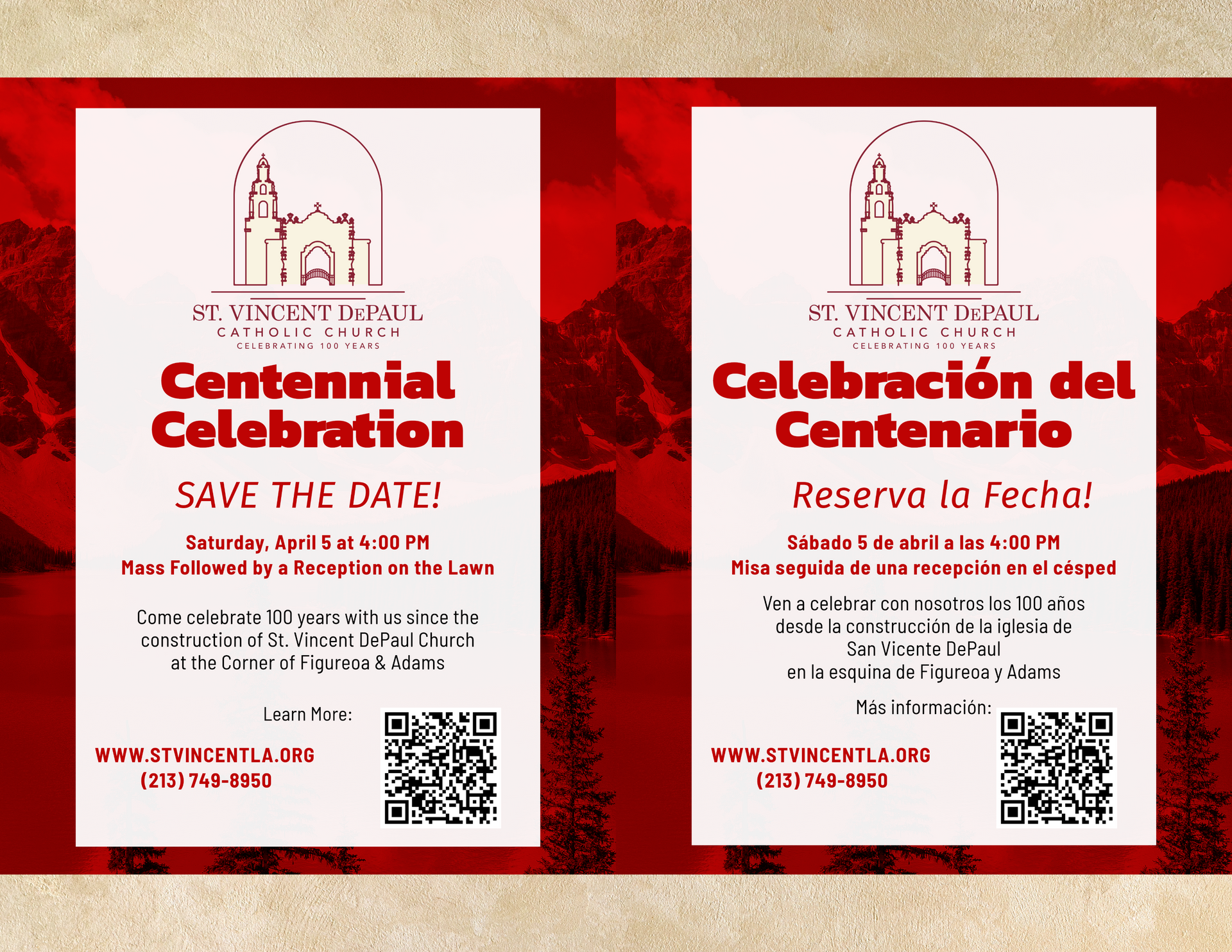The Rich Tapestry of Faith:
St. Vincent DePaul Church in Los Angeles
Founding and Growth: A Testament to Vision and Community
In the bustling metropolis of Los Angeles, with its ever-changing skyline, there stands a beacon of steadfast faith and tradition – St. Vincent DePaul Catholic Parish. Our spiritual journey begins in 1887, rooted in the pioneering foresight of Bishop Thaddeus Amat, CM, a Vincentian priest, and the first bishop of the Archdiocese of Los Angeles (then the diocese of Monterey-Los Angeles). His aspiration to bring the Vincentian presence to the West and establish a college laid the groundwork for what would become St. Vincent DePaul Catholic Parish.
Before its formal establishment as a parish, a seed was sown with St. Vincent College in 1865, the first college in Los Angeles. Its chapel served as the gathering ground for worshippers and from these humble beginnings, and under the guidance of Rev. Aloysius J. Meyer, CM, the parish sprang forth. Our parish was thus born, cradled in the arms of both education and faith at the corner of Washington and Grand. It became the third parish founded in Los Angeles, following La Placita Olvera and the Cathedral of St. Vibiana.
From the onset, education was paramount. With a commitment to never neglect the poor as outlined by Father Meyer, the Sisters of St. Joseph of Carondelet founded St. Vincent's Elementary School in 1889. The school not only taught its students the riches of the Catholic faith but nurtured them intellectually. This original vision still marks the school's enduring legacy under the sponsorship of the Daughters of Charity.
Architectural Majesty: The Doheny Legacy
As Los Angeles burgeoned, St. Vincent's met the spiritual needs of an expanding congregation. By 1907, it was evident that a new church building was on the horizon. However, World War I intervened, and plans were postponed until benefactors Mr. and Mrs. Edward L. Doheny stepped forward, deeply inspired by Estelle Doheny's religious fervor. Their generous donation fueled the construction of a new church, modeled after the grandeur of Mexican cathedrals.
The laying of the cornerstone in July 1924 heralded a new era, and on April 5, 1925, the first Eucharist was celebrated in the new church at Adams and Figueroa. This architectural gem, a testament to human effort and divine inspiration, became the most magnificent church in Los Angeles.
The Intersection of Architecture and Artistry
St. Vincent DePaul stands out not only for its religious significance but also due to its architectural splendor. The exterior by famed architect Albert C. Martin is a thoughtful mélange of Spanish Revival and Gothic nuances, intentionally positioned on a corner lot to enhance its visibility and harmonize with the surrounding architecture. Its diagonal placement is both august and inviting.
The interior is an elaborate canvas showcasing the marriage of the illustrious Ralph Adam Cram's fusion of sober American Gothic styles with the vivacious exuberance of 18th-century Mexican Baroque. The result is a space awe-inspiring yet focused, a serene haven punctuated with beautifully wrought gilding and scrollwork. While the overall design embraces the warmth of Latin Catholicism, it is meticulously tuned with Cram's touch of modernity and respect for liturgical decorum.
Spirited Expansion: The Chapel of Santo Niño
In 1945, St. Vincent's expanded its reach with the small neighborhood chapel of Santo Niño, welcoming even more parishioners to celebrate the Eucharist. This extension reinforced the parish's mission to be as close to struggling immigrants as possible, resonating with St. Vincent DePaul's call to serve the poorest among us.
Milestone: A Century as a Catholic Sanctuary
As we look towards 2025, St. Vincent DePaul Catholic Parish braces for a milestone - the centennial of our present church building on Adams and Figueroa. It remains an essential part of Los Angeles' fabric, embracing the community through worship, art, and its unwavering Catholic presence. Our coming centenary not only marks a historic architectural legacy but also a century of countless baptisms, weddings, Eucharistic celebrations, and community service – the very lifeblood of a parish. Its history is a chronicle of the Catholic faith, culture, and architectural progression converging in the heart of a bustling modern megacity. From its Spanish intricacies to its Hollywood appeal, the church will continue to herald the story of a city where cultural diversity and history intersect under the watchful eyes of its patron saint.
Sponsored by
The Vincentian Fathers & Brothers
About
Contact the Parish
621 W Adams Blvd
Los Angeles, California 90007
WeConnect | By LPi




